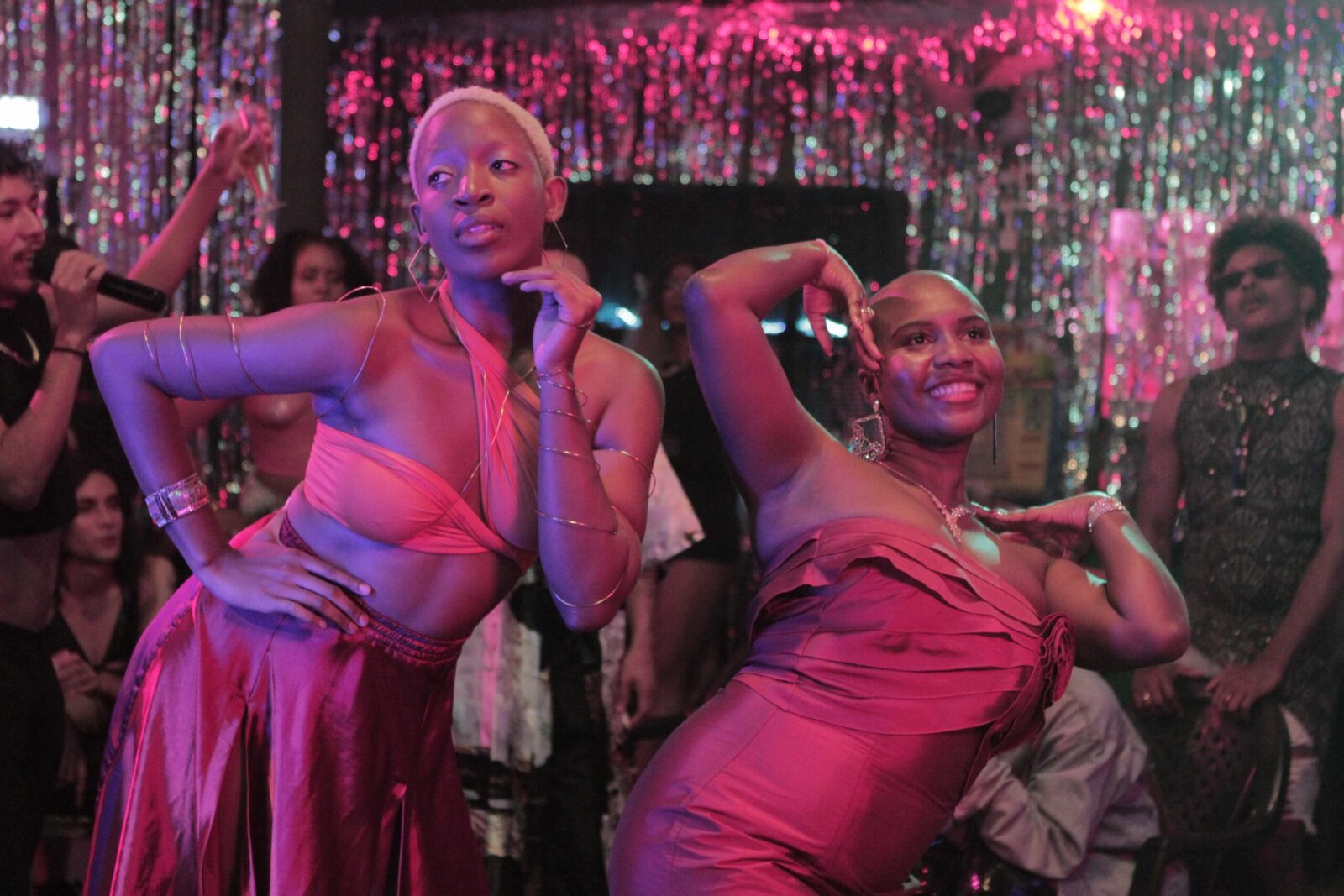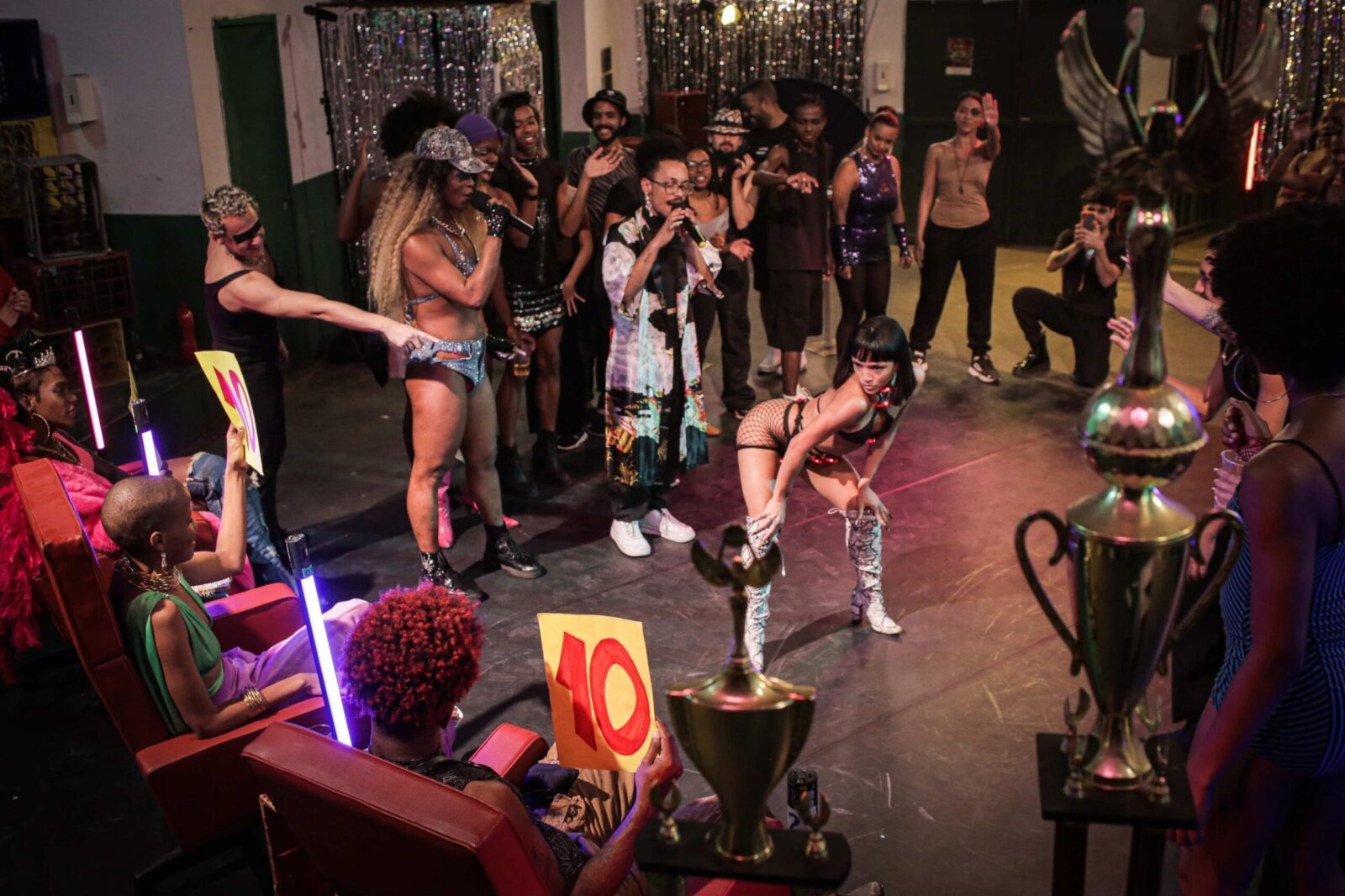
This feature length documentary is both a live record of a small staged Ball held in 2022 in Niteroi, just outside Rio de Janeiro, and a history of the Ballroom movement in Brazil, including interviews with the main personalities in some of the Brazilian Houses.
For the uninitiated, central to the Ballroom Movement is the creation of a safe space for multiracial queer people within what anarchist poet Hakim Bey called a TAZ (Temporary Autonomous Zone) This is a time and place in which the laws of normal society do not apply. Thus Ballroom becomes a home, a hospital and a church.
 In the film we are told that Ballroom was born in 1972 in the USA as an alternative black drag beauty pageant, by Crystal LaBeija, who went on to form the House of LaBeija. We see
In the film we are told that Ballroom was born in 1972 in the USA as an alternative black drag beauty pageant, by Crystal LaBeija, who went on to form the House of LaBeija. We see
We then learn how the Ballroom movement was imported by Brazilians as late as 2015 when the first Ball called The Witch Convention was held. From small beginnings it has spread to cover all parts of the country.
Ballroom organises itself into Houses which compete in performance categories, with very rigid rules. For example Queens can get “chopped” or eliminated because they have not kept to the strict regulations of a performance regardless of how talented they are.
 And in case you haven’t seen Ryan Murphy’s “Pose” the Houses are also literally homes where members of a House live together as a family. Each House has a Mother who presides over her Children. Many of these Children have been exiled from their natural families for being non gender or non sex conforming. The American Houses often take the names of famous fashion labels. The Brazilian Houses have titles like House of Alafia, House of Blyndex, Casa de Cosmos, House of Imperious, House of Mamba Negra, to name a few.
And in case you haven’t seen Ryan Murphy’s “Pose” the Houses are also literally homes where members of a House live together as a family. Each House has a Mother who presides over her Children. Many of these Children have been exiled from their natural families for being non gender or non sex conforming. The American Houses often take the names of famous fashion labels. The Brazilian Houses have titles like House of Alafia, House of Blyndex, Casa de Cosmos, House of Imperious, House of Mamba Negra, to name a few.We are introduced to the main vogueing styles through some stunning and energetic performances by the legends of the Brazilian scene. In their often touching interviews we hear of their struggles, their flirtations with prostitution and the constant threat of violence against them.
Old Way is traditional masculine vogueing which became more feminised with time. New Way vogueing highlights choreography but these moves are dismissed in the film as the speciality of privileged dance-trained whites.
Murder on the Dancefloor? Half way into the movie a fight erupts and we are reminded that not all is peace and love in the Ballroom movemen.There is a huge element of competition between the Houses but there is also no love lost between the Femme Queens, who seem to run the scene, and the other trans and non binary members. Gender is still a stumbling block for those who wish to embrace both or neither genders.
However, race more than sexuality or gender defines Brazilians most. There is an opinion that the whites who brought the scene to Brazil were engaging in cultural appropriation. Although originating in North America the roots of Ballroom are still Afrodiasporic, and black Brazilians feel justified in claiming Ballroom culture as their own.
What we don’t find enough about in this documentary, is how Brazilian Ballroom differs from American Ballroom. From my own observations Brazilian Ballroom appears less chaotic than American Ballroom. (Of course this may be because of the staged nature of the Niteroi Ball or the editing of the film.) It also seems to concentrate on the feminine, with less time given to Butch Queen performances.
There is a focus on vogueing and there seems to be less emphasis on clothing in the myriad runway categories which you can find in the USA. For example, where are the Male Figures and Sex Sirens?However, Batekoo i.e. twerking or ass shaking appears to be a particularly new and exciting Brazilian category. (Not a surprise in a country which had a popular satirical magazine called “Bundas” focusing on butts of all shapes and sizes! But I digress…).
I would also liked to have discovered a lot more about the influences of Capoeira, Macumba and Samba and if queer folks are welcome in the traditional Samba schools of Rio. Is there prejudice in Carnival? What are the similarities and differences between Ballroom and Carnival?
So to sum up, as a peephole into Brazilian Ballroom this documentary is fascinating and almost academic in its approach, but it is lacking in historical details and local information. There are moments of drama and real emotion but it is not the Brazilian version of Paris is Burning.
Robert Malcolm is an Interior Designer who relocated from London to his home town of Edinburgh in 2019. Under the pen name of Bobby Burns he had his first novel, a gay erotic thriller called Bone Island published by Homofactus Press in 2011.

 In the film we are told that Ballroom was born in 1972 in the USA as an alternative black drag beauty pageant, by Crystal LaBeija, who went on to form the House of LaBeija. We see
In the film we are told that Ballroom was born in 1972 in the USA as an alternative black drag beauty pageant, by Crystal LaBeija, who went on to form the House of LaBeija. We see  And in case you haven’t seen Ryan Murphy’s “Pose” the Houses are also literally homes where members of a House live together as a family. Each House has a Mother who presides over her Children. Many of these Children have been exiled from their natural families for being non gender or non sex conforming. The American Houses often take the names of famous fashion labels. The Brazilian Houses have titles like House of Alafia, House of Blyndex, Casa de Cosmos, House of Imperious, House of Mamba Negra, to name a few.
And in case you haven’t seen Ryan Murphy’s “Pose” the Houses are also literally homes where members of a House live together as a family. Each House has a Mother who presides over her Children. Many of these Children have been exiled from their natural families for being non gender or non sex conforming. The American Houses often take the names of famous fashion labels. The Brazilian Houses have titles like House of Alafia, House of Blyndex, Casa de Cosmos, House of Imperious, House of Mamba Negra, to name a few.
